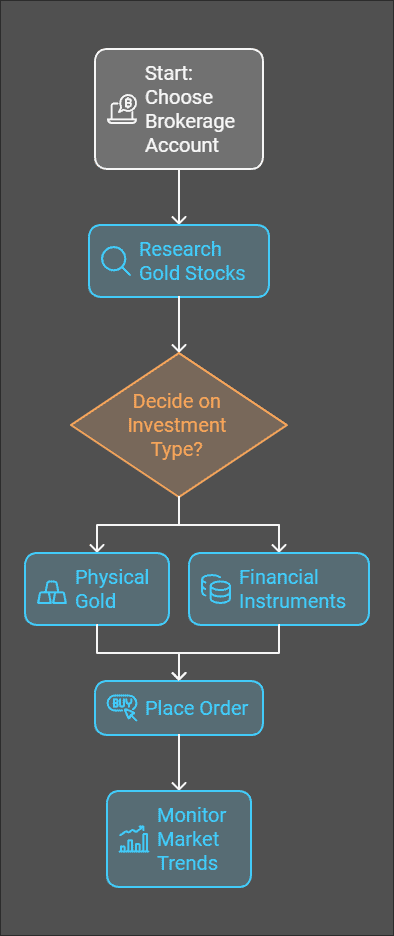Investing in gold through the stock market, including options like gold stocks and exchange-traded funds (ETFs), offers a strategic approach to diversifying your investment portfolio and safeguarding wealth against economic instability. Gold, known for its intrinsic value and historical importance, serves as a reliable hedge against inflation and economic downturns.
The value of gold is driven by its scarcity, demand from industries like jewelry manufacturing, and its role as a safe-haven asset, especially during uncertain economic or political climates. Additionally, gold prices are influenced by factors such as market demand for physical gold, including gold bullion and gold coins.
To invest in gold via the stock market, investors can explore options such as:
- Gold stocks, which represent shares in companies involved in gold mining
- Exchange-traded funds (ETFs) like SPDR Gold Shares, which are listed on exchanges such as the New York Stock Exchange
- Mutual funds focusing on gold and precious metals, providing diversification in gold mining stocks and commodities
Each of these avenues provides different levels of exposure to gold’s price movements and potential returns.
Begin by choosing a suitable brokerage account, such as Fidelity, conducting thorough research on gold stocks, and deciding on your preferred form of gold investment, whether it be physical gold like gold bullion or financial instruments like gold futures and gold options. By understanding these key elements, you can make informed decisions and maximize the potential benefits of investing in gold.

Key Takeaways:
- Investing in gold can diversify your portfolio and protect against inflation, economic downturns, and uncertainties, forming a robust diversification strategy.
- When buying gold stocks in the stock market, research the company’s financial stability, management, production, and political climate.
- Be aware of the risks involved, such as volatile gold prices, company-specific risks, and market and economic risks.
What is Gold?
Gold is a precious metal known for its rarity and intrinsic value.
Gold is used in forms such as gold bullion, gold coins like the Krugerrand, American Eagle, and Canadian Maple Leaf, and gold jewelry.
Gold serves as a financial asset and hedge against economic instability.
What Gives Gold its Value?
Gold’s value comes from its scarcity, historical importance, and role as a safe-haven asset during economic instability and inflation.
Gold’s value increases due to demand from jewelry manufacturers, central banks diversifying reserves, and investment in commodities, including physical gold and gold funds.
Investors often turn to gold during uncertain political climates, preserving wealth as fiat currencies lose value.
Why Invest in Gold?
Investing in gold is beneficial because gold acts as a hedge against inflation, retains value during economic downturns, and diversifies investment portfolios. Gold prices often increase when other assets decline, providing stability. Gold also offers liquidity, making it easy to buy and sell in various markets through gold dealers and exchanges such as the Chicago Mercantile Exchange.
What Are the Benefits of Investing in Gold?
Investing in gold offers benefits such as protection against inflation, diversification of investment portfolio, and stability during economic downturns.
Gold retains value during market fluctuations and provides liquidity for quick cash conversion.
Gold stocks offer exposure to price movements and potential returns, mitigating stock market risks.
How to Buy Gold in the Stock Market?
To buy gold in the stock market, investors can purchase gold stocks, invest in exchange-traded funds (ETFs) like SPDR Gold Shares, or buy mutual funds focused on precious metals and gold mining stocks.
Gold stocks represent shares in companies that mine or deal in gold, while ETFs, such as SPDR Gold Shares, track the price of gold and offer liquidity and convenience.
Mutual funds provide diversified exposure to gold by investing in a range of mining stocks.
Step 1: Choose a Brokerage Account
To start investing in gold, choose a brokerage account that offers access to gold stocks and ETFs.
Evaluate brokerage accounts based on fee structures, available research tools, customer support, and a range of gold investment options.
Choosing the right brokerage account ensures alignment with investment goals and strategies.
Step 2: Research and Analyze Gold Stocks
- Step 2: Research and analyze gold stocks by focusing on companies in the gold mining sector, their financial stability, and market performance.
- Analyze metrics such as debt-to-equity ratios, cash flow stability, and operating margins to assess resource management amid fluctuating gold prices.
- Evaluate production levels, growth potential, and geopolitical and operational risks to understand a company’s overall health.
- This thorough analysis aids in making informed investment decisions in gold stocks.
Step 3: Decide on the Type of Gold Investment
In deciding on the type of gold investment, consider physical gold such as gold bullion or gold coins and financial instruments like gold options or gold futures traded on platforms like the Chicago Mercantile Exchange.
Gold bullion offers high purity and liquidity but involves storage costs. Gold coins provide collectible value with higher premiums. Gold futures allow speculation on prices without physical ownership, carrying higher risk.
Selecting the right type of gold investment depends on aligning it with financial goals and risk tolerance.
Step 4: Place Your Order
To place your gold investment order, whether you are looking to purchase gold stocks, ETFs, or gold futures, log into your brokerage account and go to the trading section.
Review current market conditions and consider using limit orders to set desired purchase prices.
Monitor bid-ask spreads and check brokerage fees before placing your order.
After placing the order, track market trends to adjust your investment strategy.
What to Consider When Buying Gold Stocks?
When buying gold stocks, consider the company’s financial stability, which includes assessing its balance sheet and cash flow.
Evaluate management quality by reviewing their track record in the mining industry.
Analyze production levels and reserves to determine the potential for growth.
Consider geopolitical and economic factors, such as currency fluctuations and government policies, that affect the gold market.
1. Company’s Financial Stability
Financial stability in a gold mining company affects profitability, operational efficiency, and investment resilience.
Key financial metrics for assessing stability include:
- debt-to-equity ratio
- current assets
- EBIT
- cash flow statements
These metrics show the company’s debt management, operational efficiency, and cash generation capabilities.
Reviewing annual reports and quarterly earnings provides insights into management’s strategies and growth projections.
2. Management and Leadership
Effective management and leadership in a gold mining company improve operational success and company performance.
Leaders in gold mining must make strategic decisions for profitability and sustainability.
Strong leadership fosters safety, innovation, and compliance in operations.
Effective leaders adapt to market conditions, invest in technology, and practice responsible mining.
Good leadership enhances team cohesiveness, employee morale, and productivity.
3. Production and Reserves
Gold mining company profitability depends on production capacity and reserves.
Production capacity indicates current output efficiency, while reserves show potential longevity of operations.
Assessing these factors helps predict revenue potential and stability in gold mining.
Global gold price changes and regulations may affect production capabilities.
4. Political and Economic Factors
Political and economic factors affecting the gold market include regulatory changes, geopolitical tensions, and economic conditions.
Factors like currency value fluctuations, government policies, and central bank actions can impact gold prices.
Geopolitical unrest often increases demand for gold as a safe-haven asset.
Risks and Challenges of Buying Gold Stocks
Investing in gold stocks entails risks and challenges, including the volatility of gold prices, which can cause significant fluctuations in stock value. Consider diversifying with mutual funds or ETFs to mitigate these risks.
Company-specific risks, such as management issues or operational inefficiencies, can adversely affect stock performance.
Broader market risks, including economic downturns, can also impact the value of gold stocks.
Investors must consider these factors when assessing the potential returns of gold stock investments.
1. Volatility of Gold Prices
Volatility of gold prices refers to rapid fluctuations in gold’s market value, influenced by economic indicators such as inflation rates and interest levels.
Gold prices increase when inflation rises, as gold becomes a hedge against inflation; prices decrease with positive economic news reducing demand.
Geopolitical tensions and currency value shifts also affect gold price volatility.
2. Company-specific Risks
Company-specific risks in gold stocks include operational challenges, management decisions, and production changes affecting stock performance and investor returns.
Operational efficiency issues, like equipment failures or labor strikes, can cause downtimes and impact production targets.
The competitive landscape in the gold mining industry influences market share and pricing power.
Regulatory changes, such as environmental standards or mining permits, pose additional threats.
Evaluating these risks is essential for safeguarding investments in gold stocks.
3. Market and Economic Risks
Market and economic risks in the gold market include fluctuations in global trade policies, currency values, and interest rates.
These factors influence gold demand, attractiveness, and price movements.
Political instability in key regions can also impact investment trends.
Frequently Asked Questions
What is gold and how is it traded in the stock market?
Gold is a precious metal that has been used as a form of currency, a store of value, and in gold jewelry for centuries. In the stock market, gold is traded in the form of gold stocks, exchange-traded funds (ETFs), including popular ones like SPDR Gold Shares, and gold futures contracts. Additionally, gold bullion and gold coins such as the Krugerrand, American Eagle, and Canadian Maple Leaf are physical forms of investment.
Why should I consider buying gold in the stock market?
Gold is often seen as a safe-haven investment during times of economic uncertainty, economic downturns, or market volatility. It can act as a hedge against inflation and as a key component in a diversification strategy within a well-balanced investment portfolio.
How can I buy gold in the stock market?
There are a few different ways to purchase gold in the stock market. You can buy shares of gold ETFs or invest in gold mining companies through stocks. Alternatively, you can also trade gold futures contracts or gold options on a commodities exchange such as the Chicago Mercantile Exchange. Additionally, investing in gold can be done through mutual funds or gold funds available through financial institutions like Fidelity.
What are some factors to consider when buying gold in the stock market?
When buying gold in the stock market, it is important to consider the current market conditions, historical data on gold prices, the performance of gold mining companies, and the expense ratios of gold ETFs. It is also crucial to have a clear understanding of your investment strategy, including your investment goals and risk tolerance.
Are there any risks associated with buying gold in the stock market?
As with any investment, there are risks involved in buying gold in the stock market. Gold prices can be volatile and are subject to market forces, economic factors, and changes in the gold market. Additionally, investing in individual gold mining stocks can be riskier than investing in a diversified ETF.
Can I easily sell my gold investments in the stock market?
Yes, you can sell your gold investments in the stock market at any time, just like any other stock or ETF on the New York Stock Exchange. However, it is important to keep in mind that there may be costs and fees associated with selling your investments. It is also advisable to consult gold dealers or financial advisors to enhance your investment strategy, so it is important to carefully consider your investment decisions before buying.
Authors & Disclosures
- Our content is independently written and reviewed by trusted reviewers & fact-checkers.
- We can earn money by connecting you with top Gold IRA Companies. Learn how our reviews work.
- Want to learn more? Meet our authors and explore our editorial policy.















